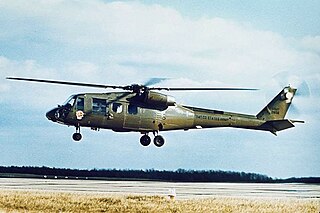Related Research Articles

The Sikorsky UH-60 Black Hawk is a four-blade, twin-engine, medium-lift utility military helicopter manufactured by Sikorsky Aircraft. Sikorsky submitted the S-70 design for the United States Army's Utility Tactical Transport Aircraft System (UTTAS) competition in 1972. The Army designated the prototype as the YUH-60A and selected the Black Hawk as the winner of the program in 1976, after a fly-off competition with the Boeing Vertol YUH-61.
Sikorsky Aircraft is an American aircraft manufacturer based in Stratford, Connecticut. It was established by the Russian aviation pioneer Igor Sikorsky in 1923, and was among the first companies to manufacture helicopters for civilian and military use. It also produced seaplanes for passenger transport and surface vehicles such as trains and boats.

The Boeing–Sikorsky RAH-66 Comanche is an American stealth armed reconnaissance and attack helicopter designed for the United States Army. Following decades of study and development, the RAH-66 program was cancelled in 2004 before mass production began, by which point nearly US$7 billion had been spent on the program.

The Piasecki X-49 "SpeedHawk" is an American four-bladed, twin-engined experimental high-speed compound helicopter developed by Piasecki Aircraft. The X-49A is based on the airframe of a Sikorsky YSH-60F Seahawk, but utilizes Piasecki's proprietary vectored thrust ducted propeller (VTDP) design and includes the addition of lifting wings. The concept of the experimental program was to apply the VTDP technology to a production military helicopter to determine any benefit gained through increases in performance or useful load.

The Piasecki Aircraft Corporation (PiAC) is a manufacturer of aircraft, principally advanced rotorcraft. It was founded by American vertical flight pioneer Frank Piasecki to develop compound helicopters and other advanced rotorcraft after he was ousted from the leadership of his first company, Piasecki Helicopter.

The Sikorsky CH-53K King Stallion is a heavy transport helicopter designed and produced by Sikorsky Aircraft. The King Stallion is an evolution of the long running CH-53 series of helicopters which has been in continuous service since 1966, and features three up-rated 7,500 shp (5,590 kW) engines, new composite rotor blades, and a wider aircraft cabin than its predecessors. It is the largest and heaviest helicopter in the U.S. military.

The EurocopterUH-72 Lakota is a twin-engine helicopter with a single, four-bladed main rotor. The UH-72 is a militarized version of the Eurocopter EC145, built by American Eurocopter, a division of Airbus Group, Inc. Several hundred UH-72 of various types have entered service by the 2020s since their introduction in 2006.

The Sikorsky S-72 was an experimental Sikorsky Aircraft compound helicopter developed as the Rotor Systems Research Aircraft (RSRA) for the National Aeronautics and Space Administration (NASA) and the United States Army. The RSRA was a testbed for rotor and propulsion systems for high-speed.

The Boeing Vertol YUH-61 was a twin turbine-engined, medium-lift, military assault/utility helicopter. The YUH-61 was the runner-up in the United States Army Utility Tactical Transport Aircraft System (UTTAS) competition in the early 1970s to replace the Bell UH-1 Iroquois helicopter. At the end of the flyoff program, Sikorsky Aircraft was awarded a contract to develop and build its UH-60A entry.

The Bell Boeing Quad TiltRotor (QTR) is a proposed four-rotor derivative of the Bell Boeing V-22 Osprey developed jointly by Bell Helicopter and Boeing. The concept is a contender in the U.S. Army's Joint Heavy Lift program. It would have a cargo capacity roughly equivalent to the C-130 Hercules, cruise at 250 knots, and land at unimproved sites vertically like a helicopter.

The United States Army Aviation Museum is an aviation museum located on Fort Novosel near Daleville, Alabama. It has the largest collection of helicopters held by a museum in the world. The museum features some 50 aircraft on public display with aviation artifacts ranging from a replica of the Wright brothers' Model B military biplane to an RAH-66 Comanche. The museum has over 160 aircraft in its collection and holds 3,000 historical items.

The Sikorsky S-97 Raider is a high-speed scout and attack compound helicopter based on the Advancing Blade Concept (ABC) with a coaxial rotor system under development by Sikorsky Aircraft. Sikorsky planned to offer it for the United States Army's Armed Aerial Scout program, along with other possible uses. The S-97 made its maiden flight on 22 May 2015.

Future Vertical Lift (FVL) is a plan to develop a family of military helicopters for the United States Armed Forces. Five different sizes of aircraft are to be developed, sharing common hardware such as sensors, avionics, engines, and countermeasures. The U.S. Army has been considering the program since 2004. FVL is meant to develop replacements for the Army's UH-60 Black Hawk, AH-64 Apache, CH-47 Chinook, and OH-58 Kiowa helicopters. The precursor for FVL is the Joint Multi-Role (JMR) helicopter program.

The Bell V-280 Valor is a tiltrotor aircraft being developed by Bell Helicopter for the United States Army's Future Vertical Lift (FVL) program. The aircraft was officially unveiled at the 2013 Army Aviation Association of America's (AAAA) Annual Professional Forum and Exposition in Fort Worth, Texas. The V-280 made its first flight on 18 December 2017 in Amarillo, Texas.

The Sikorsky–Boeing SB-1 Defiant was the Sikorsky Aircraft and Boeing entry for the United States Army's Future Long-Range Assault Aircraft program to replace the Sikorsky UH-60 Black Hawk. It is a compound helicopter with rigid coaxial rotors, powered by two Honeywell T55 turboshaft engines; it first flew on 21 March 2019.

The General Electric T901 (GE3000) is a turboshaft engine in the 3,000 shp (2,200 kW) class currently under development for the United States Army's Improved Turbine Engine Program (ITEP). The ITEP plans after 2025 to re-engine over 1,300 Sikorsky UH-60 Black Hawk and more than 600 Boeing AH-64 Apache, and was intended to power the now-canceled Future Attack Reconnaissance Aircraft (FARA).
The Bell 360 Invictus was a proposed helicopter design intended to meet the United States Army requirement for a Future Attack Reconnaissance Aircraft (FARA). It is based on technology from the Bell 525 Relentless.
The Future Attack Reconnaissance Aircraft (FARA) program was initiated by the United States Army in 2018 to develop a successor to the Bell OH-58 Kiowa scout helicopter as part of the Future Vertical Lift program. The OH-58 was retired in 2017; three prior programs for a successor were cancelled prior to reaching production: Light Helicopter Experimental, Armed Reconnaissance Helicopter, and Armed Aerial Scout. Several billions of dollars were spent without delivering any new helicopters to service, due to this cycle of development and cancellation. During this time the armed scout role was filled primarily by the Vietnam-era OH-58, which was finally retired in the late 2010s, leaving the Army to use attack helicopters to fill in this role.
The Sikorsky Raider X is a compound helicopter concept with two coaxial rotors and a single pusher propeller, designed by the Sikorsky Aircraft division of Lockheed Martin for the United States Army Future Attack Reconnaissance Aircraft (FARA) program. The Raider X concept was announced in October 2019. In March 2020, the Army selected the Raider X and the Bell 360 Invictus from a field of five design concept candidates. The Raider X and 360 Invictus concepts were to be built as flying prototypes for a competition scheduled for 2023. The FARA program was cancelled in 2024.

Nicholas D. Lappos was the program director for the Sikorsky S-92 helicopter. He shepherded the S-92 program through FAA certification. Sikorsky Aircraft and the S-92 team, led by Nicholas Lappos, were awarded the 2002 Collier Trophy for their work on the S-92.
References
- ↑ "Army announces Future Long Range Assault Aircraft contract award". U.S. Army. 5 December 2022. Archived from the original on 4 June 2023. Retrieved 5 December 2022.
- ↑ Sharma, Soumya (29 December 2022). "Sikorsky files protest against US Army's FLRAA contract decision". Army Technology. Archived from the original on 12 April 2023. Retrieved 2 April 2023.
- ↑ "GAO Statement on Protest of Sikorsky Aircraft Corporation, B-421359, B-421359.2". U.S. Government Accountability Office. 6 April 2023. Archived from the original on 1 October 2023. Retrieved 7 April 2023.
- ↑ Roque, Ashley (6 April 2023). "GAO denies Sikorsky-Boeing FLRAA protest; Bell, Army clear to proceed". Breaking Defense. Archived from the original on 21 December 2023. Retrieved 10 January 2024.
- 1 2 3 "RFI Intent". United States Army. April 4, 2019. Retrieved 16 October 2019.
- 1 2 Judson, Jen (30 March 2018). "Army Future Vertical Lift hones in on attack recon, long-range assault". Defense News. Archived from the original on 30 March 2018. Retrieved 16 October 2019.
- ↑ Judson, Jen (29 April 2016). "First Future Vertical Lift Helicopters Will Be Medium-Lift". Defense News. Archived from the original on 9 October 2018. Retrieved 16 October 2019.
- ↑ Judson, Jen (4 April 2019). "US Army plans to field a future long-range assault helicopter by 2030". Defense News. Archived from the original on 10 January 2024. Retrieved 16 October 2019.
- ↑ Parsons, Dan (16 March 2020). "Bell's Valor, Sikorsky/Boeing Defiant advance in U.S. Army Future Assault Aircraft program". Vertical. Archived from the original on 9 April 2023. Retrieved 26 March 2020.
- ↑ Jen Judson (8 February 2024) US Army spent billions on a new helicopter that now will never fly
- ↑ Ashley Rocque (8 February 2024) Army cancels FARA helicopter program, makes other cuts in major aviation shakeup
- ↑ Ashley Rocque (2 Aug 2024) Milestone B: Army’s FLRAA tiltrotor graduates to engineering and manufacturing development phase